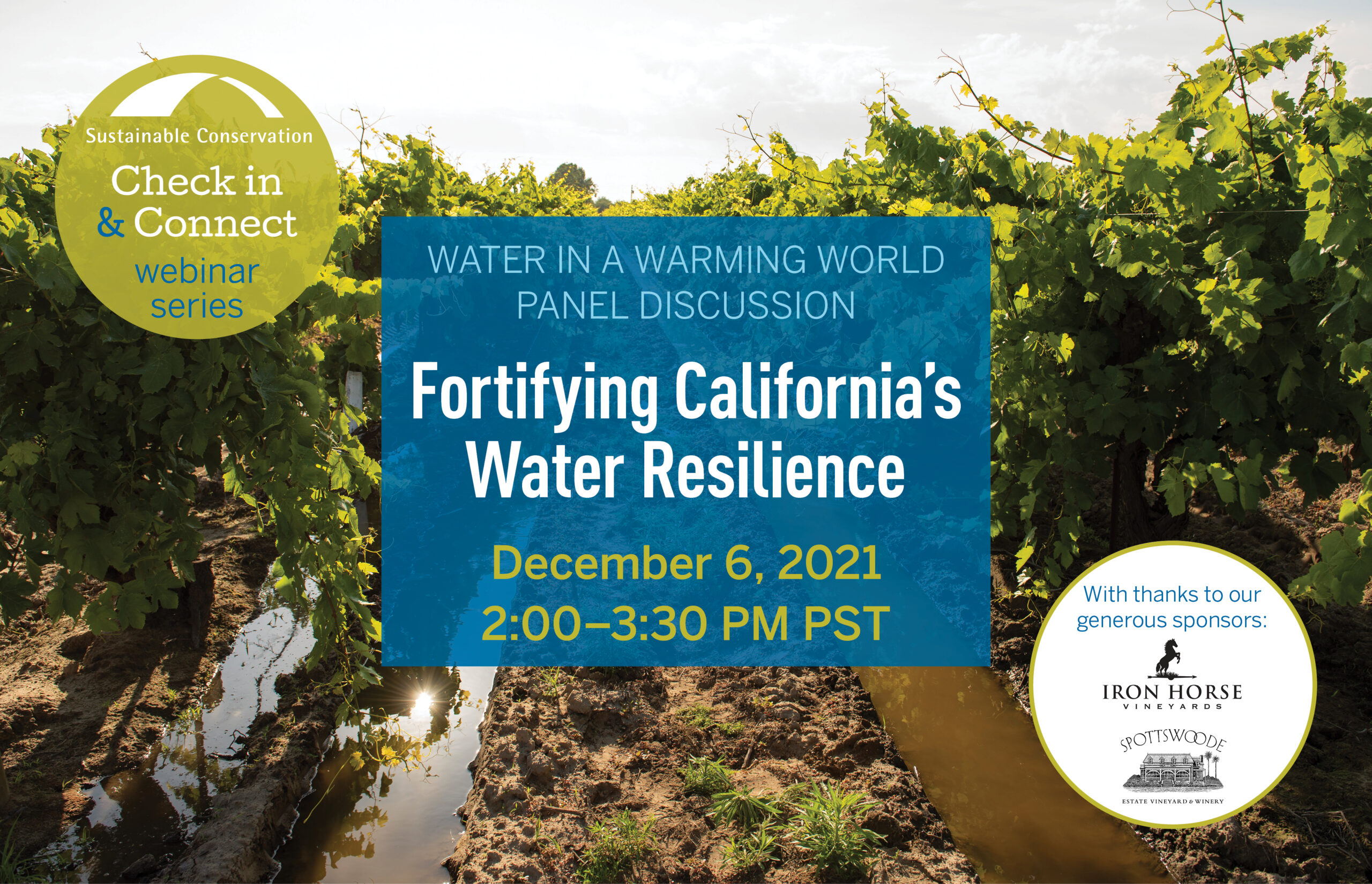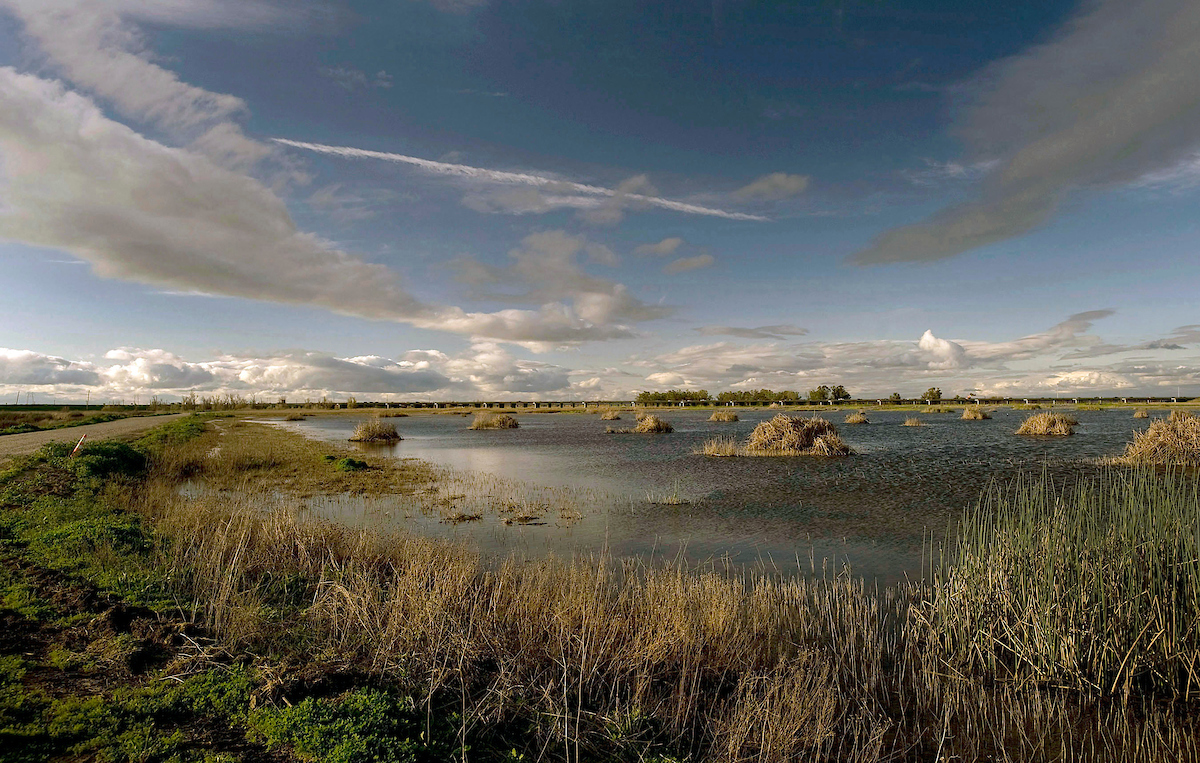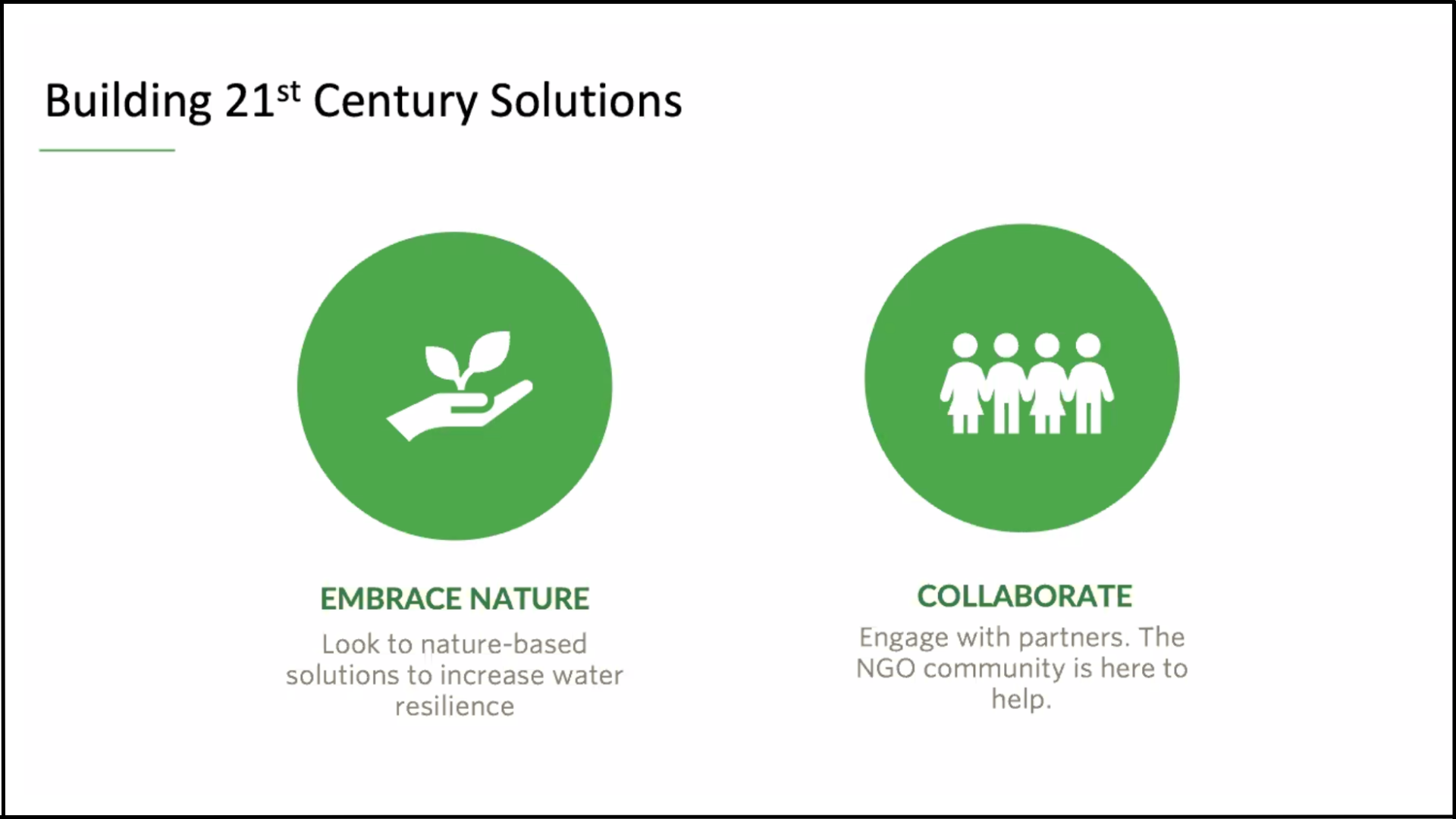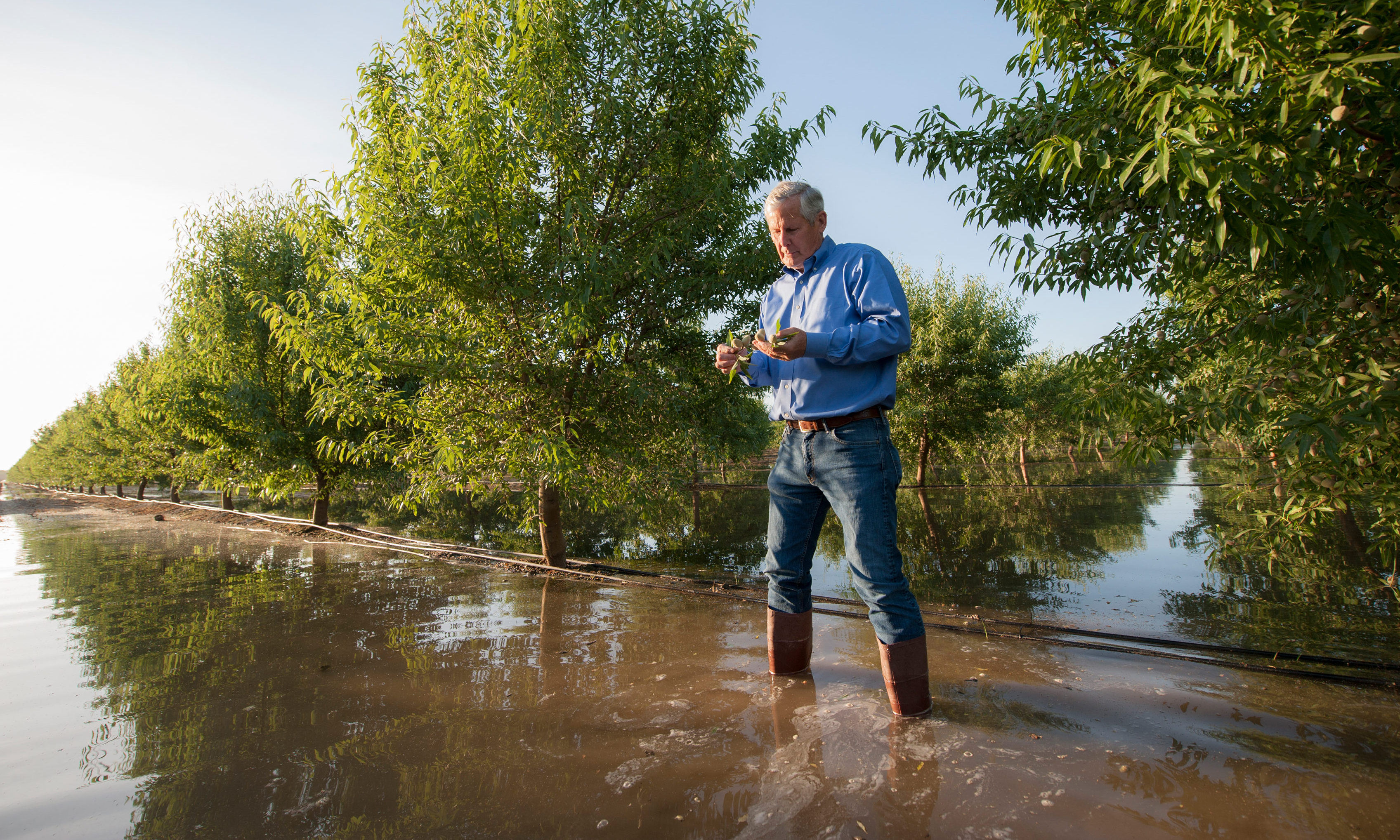
Missed the latest webinar in our Water in a Warming World series? We’ve got you covered with highlights and a full recording of the event.
Sustainable Conservation’s Director of Resource Stewardship Dr. Daniel Mountjoy moderated a fantastic panel of experts who discussed how groundwater recharge and multi-benefit projects can help California fortify our water resilience. Our panel included recharge pioneer Don Cameron of Terranova Ranch, Sandi Matsumoto of The Nature Conservancy, and Jennifer Marr of the California Department of Water Resources (DWR).
Thank you to our generous webinar series sponsors Iron Horse Vineyards and Spottswoode Estate Vineyard & Winery!
Managing Floods When They Happen
Marr began with a look at how we can manage flood waters, and how we can shift our thinking, too. Drought is a way of life for Californians, but our dry times are becoming more extreme. As our planet warms and our precipitation changes – snowmelt turns into rain, flooding becomes flashier – we need to be ready to take water off of our rivers in larger quantities, and more quickly. Marr noted that systems thinking, or a “headwaters to groundwater” approach, is key to transforming our water management.
Flood-MAR projects can be as simple as one farmer on a field, or as complex and integrated as a watershed-level plan. We can also change the way we operate our reservoirs to measure out our flood flows, and make more space for bigger runoff events that come in. And, critically, we can use floodplains to help pull water off of rivers when they’re running fast and deep. Floodplains create habitat for wildlife like salmon and migratory birds, and they allow rivers to spread out and slow down so downstream communities can be safe, too.

Projects like the Yolo Bypass provide habitat for salmonids and waterfowl while reducing flood risks for communities. Photo: Steve Payer/California Department of Water Resources.
21st-Century Hydrology
Matsumoto added additional context: when we built our water infrastructure (our canals and reservoirs) we based them on 20th-century water models. As Marr said earlier, our water reality is changing, and that stark reality hits when our reservoirs drop to unprecedented levels. 27 million people rely on the State Water Project for water – for farming, drinking, and household use – and they’ll likely receive no water from these allocations in 2022.
“We are at a crossroads in California where we have to think about managing our systems differently. Our ecosystems and communities are suffering.” – Sandi Matsumoto
Changing how we operate reservoirs is one part of the equation, but Matsumoto offered a three-pronged approach to build on Marr’s previous points. We have to reduce our flood risk for our downstream communities, increase our water supply, and reduce our water demand. To get here, we can utilize floodplains and multi-benefit groundwater recharge projects, and restore arid upland habitat when agricultural land comes out of production.
With 50% of our freshwater plants and animals at risk of extinction in our kids’ lifetime and 95% of our riparian habitat gone, we clearly need these systems-based solutions.

We can build 21st-century solutions by embracing nature, and collaborating to get projects on the ground. Slide courtesy of Sandi Matsumoto, The Nature Conservancy.
Traditional Flood Management Needs an Update
When we use levies, we create hard barriers against which peak flood flows ricochet back into the river. The water has nowhere to go, so it speeds up and becomes a significant threat. Salmon can’t swim upstream or spawn in fast flows, people’s homes and business are at risk, and farms need to manage their riparian-adjacent fields for severe flooding that can damage crops and wipe out infrastructure.
Matsumoto offered a key case study on the Santa Clara River in Ventura County, where new developments were threatened by flooding to the tune of 21,000 at-risk homes, and $1 billion dollars in potential damage. The Nature Conservancy and a coalition of willing partners worked together to establish flood easements with landowners who owned property along the river.
The result? A solution that cost 20% of the price of new levies ($2 million vs. $10 million), new wildlife habitat, and a 25% reduction in flood insurance for Ventura County residents.
Getting Water Back Into The Ground
Planning and funding these large, watershed-scale projects are challenging, but what does it take to implement them on the ground? Cameron’s a groundwater recharge pioneer with 40 years of farming under his belt – and 30 of those years spent experimenting with groundwater recharge on his active cropland.
Cameron walked us through the evolution of Terranova Ranch’s recharge work, and the McMullin Area Groundwater Sustainability Agency’s planning and future groundwater projects. Beginning with a single canal built in 1996 and a robust pilot in 2011, Cameron’s now spearheading an impressive, area-wide infrastructure transformation.
“As farmers, we’ve seen the changes. We know they’re real, and we know they’re here.” – Don Cameron
When the 2011 pilot netted a 40-foot increase in groundwater levels below, Cameron knew they had to expand. He went on to test groundwater recharge on a variety of crops like wine grapes, pistachios, almonds, walnut,s and even olives – with a high water mark of 2.5 feet on the pistachios! Everything came through well, and while Cameron isn’t saying recharge is easy, careful attention and timing can make it successful.
The main challenge? A pincer effect of infrastructure and funding gaps, which Cameron noted affects more than just his operation. Smaller landowners and interested farmers who can’t build partnerships or don’t have time to go for significant funding opportunities also need opportunities to try recharge.
Still, Cameron and partners persisted to get their new infrastructure built, and the system’s able to push 500 cubic feet of water per second, which is the equivalent of adding 1 foot of water on 1,000 acres of land, per day.

Don Cameron stands in a flooded almond orchard during one of Terranova Ranch’s many recharge events. Photo: Paolo Vescia.
Above, and Below
Just like groundwater recharge, water storage is part of the solution. But it’s expensive, time-consuming to build and takes a good deal of public goodwill and effort. Expanding how we think about places we can store water – either above the ground or below it – means we can be more resilient. We can put water back into our aquifers when it’s available during our droughts. We can also make more space for water in our reservoirs and on our floodplains, and meter it out for environmental flows, water needs, and community safety.
Marr, Matsumoto, and Cameron all agree: to build a resilient water future in California, we need the time, funding, and space to think about creative, holistic solutions. Matsumoto added that we’re in a necessarily reactive time right now – we have immediate, severe drought to contend with. We need immediate solutions, but we also need a seismic shift in modeling and managing our water for the future.
Projects like The Nature Conservancy’s coalitions, DWR’s Flood-MAR Network, Cameron’s on-site transformations, and Sustainable Conservation’s decade-plus of recharge siting, testing, and promotion help California be responsive, build up our water reserves, and meet the needs of farms, communities, and the environment.
What’s Next?
Stick with us! Bringing people together is what we do, and we encourage you to visit our Check In & Connect page for access to all of our event recordings, and so you can catch up on any Water in a Warming World webinars you’ve missed. You can also check out our Twitter coverage of this event.
Our next webinar series kicks off next year. Stay tuned for more info!
Become a California Conservationist today to receive our awesome community benefits, and your gift will go twice as far this year to help make our events and critical California water work possible!

